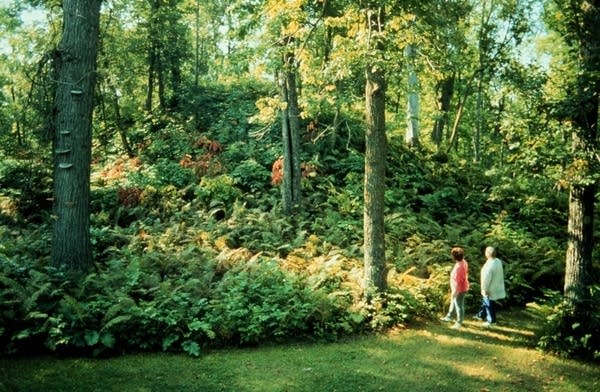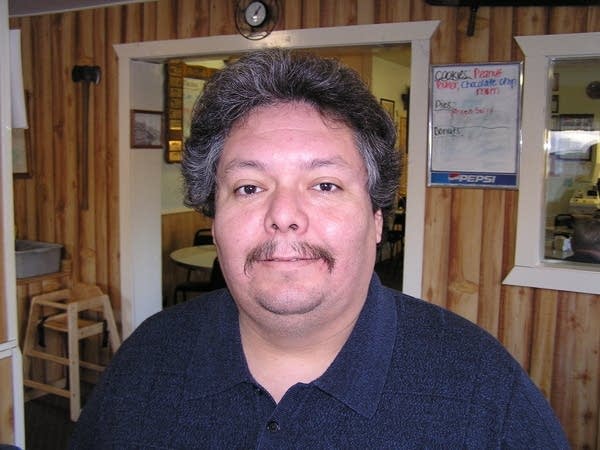Minnesota Historical Society closes Grand Mound burial site

Grand Mound is huge. It's nearly as tall as a three-story building, and half the length of a football field. Archeologists say it may have been built as early as 200 BC. That's about the time the Great Wall of China was completed, and a century before the birth of Julius Caesar.
The Grand Mound and four smaller ones were built by a mysterious group of people called the Laurel Indians. Archeologists aren't sure what happened to the Laurels. Many believe they're not related to modern-day tribes in the region.
The Laurel Indians gathered for centuries at the confluence of the Big Fork and Rainy rivers to fish for sturgeon and bury their dead. The mounds are believed to contain the remains of hundreds of people.
"What we heard from tribal elders was that this was like a cemetery, it was a burial ground, and that operating it as a tourist attraction was really not an appropriate way to go."
In 1975, The Minnesota Historical Society built an interpretive center and began offering tours of the burial site. Tourists could walk along trails surrounding the mounds. MHS officials say that's no longer appropriate.
Create a More Connected Minnesota
MPR News is your trusted resource for the news you need. With your support, MPR News brings accessible, courageous journalism and authentic conversation to everyone - free of paywalls and barriers. Your gift makes a difference.
"What we're proposing now is, indeed, a change in philosophy about the way that we deal with Indian burial sites," said Bill Keyes, who heads the organization's historic sites and museums division.
Keyes says state and federal laws over the years have created significant protections for Indian burial sites. Last year the Legislature asked MHS to study the future of Grand Mound. Keyes says the organization gathered input from Minnesota's Indian communities.
"What we heard from tribal elders was that this was like a cemetery, it was a burial ground, and that operating it as a tourist attraction was really not an appropriate way to go," said Keyes.
The center's doors have actually been locked since 2003, when the Historical Society faced huge budget cuts.
Some people in International Falls are angry about the permanent closure. Koochiching County Historical Society director Ed Oerichbauer says Grand Mound is a vital part of the region's history. He says it's also important for local tourism.
"This is an area that's struggling, like so many other rural areas, and then to shut off this economic potential is also devastating," said Oerichbauer. "On one hand you're trying to attract visitors. And it's pretty embarrassing to say well, take your money and get in your car and go someplace else. And that's what's happening."
Oerichbauer says he doesn't think MHS did enough to promote the center to tourists. And while Oerichbauer says he respects the views of Native Americans about the sacredness of the site, he believes the Historical Society's decision was more about money.

"I think that was an easy way out for them," he said. "Because they had closed it, and using political correctness now to validate their initial closure is, I think, quite fortuitous for them. And I just think it's a mistake, that's all."
MHS officials say money was a factor in the decision to close the site. Annual attendance at Grand Mound had been declining since 1991, when there were nearly 8,000 visitors. In 2002, the year prior to its closure, that number dropped below 2,000. That made it expensive to operate.
While the average cost per visitor for other MHS facilities is $8.36, the average cost per visitor at Grand Mound was nearly $54. Officials say the problem is that the center is in a very remote, sparsely populated area.
Many in the Indian community are happy Grand Mound will stay closed. Jim Jones is a cultural resource specialist with the Minnesota Indian Affairs Council. In 1990, Jones helped rebury some 300 people who had been unearthed in the mounds by archeologists in the 1960s.
Jones says the Historical Society is doing the right thing.
"It's a place that people came to, time and time again, and brought their loved ones," said Jones. "They brought those people back up to Grand Mound for a particular reason. And the consensus from the communities is, no, we leave it closed because it's a sacred site."
The Historical Society has gated the entrance to Grand Mound and mothballed the interpretive center. MHS will continue to preserve and secure the site, at a cost of around $10,000 a year.
Meanwhile, Grand Mound is under consideration as a National Historic Landmark by the National Park Service. The site has been on the National Register of Historic Places since 1972, but landmark status would further recognize it as having outstanding national historic significance.
That decision will come later this year. MHS officials say earning the designation isn't expected to change Grand Mound's closed status.
